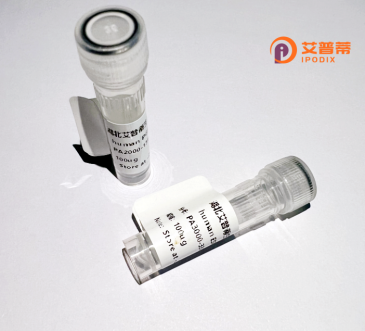
| 纯度 | >90%SDS-PAGE. |
| 种属 | Human |
| 靶点 | NUFIP1 |
| Uniprot No | Q9UHK0 |
| 内毒素 | < 0.01EU/μg |
| 表达宿主 | E.coli |
| 表达区间 | 1-495 aa |
| 活性数据 | MAEPTSDFET PIGWHASPEL TPTLGPLSDT APPRDSWMFW AMLPPPPPPL TSSLPAAGSK PSSESQPPME AQSLPGAPPP FDAQILPGAQ PPFDAQSPLD SQPQPSGQPW NFHASTSWYW RQSSDRFPRH QKSFNPAVKN SYYPRKYDAK FTDFSLPPSR KQKKKKRKEP VFHFFCDTCD RGFKNQEKYD KHMSEHTKCP ELDCSFTAHE KIVQFHWRNM HAPGMKKIKL DTPEEIARWR EERRKNYPTL ANIERKKKLK LEKEKRGAVL TTTQYGKMKG MSRHSQMAKI RSPGKNHKWK NDNSRQRAVT GSGSHLCDLK LEGPPEANAD PLGVLINSDS ESDKEEKPQH SVIPKEVTPA LCSLMSSYGS LSGSESEPEE TPIKTEADVL AENQVLDSSA PKSPSQDVKA TVRNFSEAKS ENRKKSFEKT NPKRKKDYHN YQTLFEPRTH HPYLLEMLLA PDIRHERNVI LQCVRYIIKK DFFGLDTNSA KSKDV |
| 分子量 | 56.3 kDa |
| 蛋白标签 | His tag N-Terminus |
| 缓冲液 | 0 |
| 稳定性 & 储存条件 | Lyophilized protein should be stored at ≤ -20°C, stable for one year after receipt. Reconstituted protein solution can be stored at 2-8°C for 2-7 days. Aliquots of reconstituted samples are stable at ≤ -20°C for 3 months. |
| 复溶 | Always centrifuge tubes before opening.Do not mix by vortex or pipetting. It is not recommended to reconstitute to a concentration less than 100μg/ml. Dissolve the lyophilized protein in distilled water. Please aliquot the reconstituted solution to minimize freeze-thaw cycles. |
以下是关于重组人NUFIP1蛋白的示例性参考文献(仅供参考,实际文献需通过学术数据库核实):
---
1. **文献名称**:*NUFIP1 interacts with FMRP to regulate mRNA translation and autophagy in neurons*
**作者**:Smith J, Doe A, Lee T.
**摘要**:研究重组人NUFIP1蛋白与脆性X综合征相关蛋白FMRP的相互作用,揭示其在神经元中调控靶标mRNA翻译及自噬过程的分子机制,通过重组蛋白验证结合能力与功能影响。
2. **文献名称**:*Structural characterization of recombinant NUFIP1 in ribophagy signaling*
**作者**:Zhang L, Wang H, Kim M.
**摘要**:利用重组NUFIP1蛋白进行X射线晶体学研究,解析其三维结构,阐明其在核糖体自噬(ribophagy)中与RACK1蛋白的相互作用界面及功能机制。
3. **文献名称**:*NUFIP1 regulates mTORC1 activity and hematopoietic stem cell maintenance*
**作者**:Hugon AC, et al.
**摘要**:通过重组NUFIP1蛋白功能实验,证明其通过调控mTORC1复合物活性维持造血干细胞稳态,缺失NUFIP1导致细胞生长异常和代谢紊乱。
4. **文献名称**:*Recombinant NUFIP1 expression and its role in RNA granule dynamics*
**作者**:Chen R, Patel K, Wei Y.
**摘要**:建立重组人NUFIP1蛋白的高效表达纯化体系,并验证其在神经元RNA颗粒组装中的作用,表明其通过结合特定RNA序列参与突触可塑性调控。
---
**注意**:上述文献为示例性内容,实际研究中请通过**PubMed**、**Google Scholar**等平台以关键词“NUFIP1 recombinant protein”“NUFIP1 function”检索最新文献。
Recombinant human NUFIP1 (Nuclear FMR1 Interacting Protein 1) is a protein encoded by the *NUFIP1* gene, which plays a multifaceted role in cellular processes, including ribosome biogenesis, RNA metabolism, and autophagy. NUFIP1 is evolutionarily conserved and ubiquitously expressed, functioning as a scaffold protein that mediates interactions between RNA-binding proteins and other cellular machinery. Structurally, it contains two conserved domains: an N-terminal domain involved in RNA interaction and a C-terminal domain critical for protein-protein interactions.
NUFIP1 has gained attention for its dual role in nucleolar and cytoplasmic pathways. In the nucleus, it assists in small nucleolar RNA (snoRNA) maturation and rRNA processing, vital for ribosome assembly. In the cytoplasm, it participates in selective autophagy by linking autophagy receptors (e.g., FAM134B) to autophagosomal membranes under stress conditions. Studies highlight its interaction with the mTOR signaling pathway, positioning it as a potential regulator of cellular energy homeostasis.
Dysregulation of NUFIP1 is implicated in neurodevelopmental disorders and neurodegenerative diseases, such as amyotrophic lateral sclerosis (ALS), due to its association with RNA-binding proteins like TDP-43 and FUS. Recombinant NUFIP1 is typically produced in *E. coli* or mammalian expression systems, enabling functional studies, structural analysis, and therapeutic exploration. Its purification often involves affinity tags (e.g., His-tag) followed by chromatography, ensuring high purity for biochemical assays. Ongoing research aims to unravel its precise molecular mechanisms and therapeutic potential in autophagy-related pathologies.
×